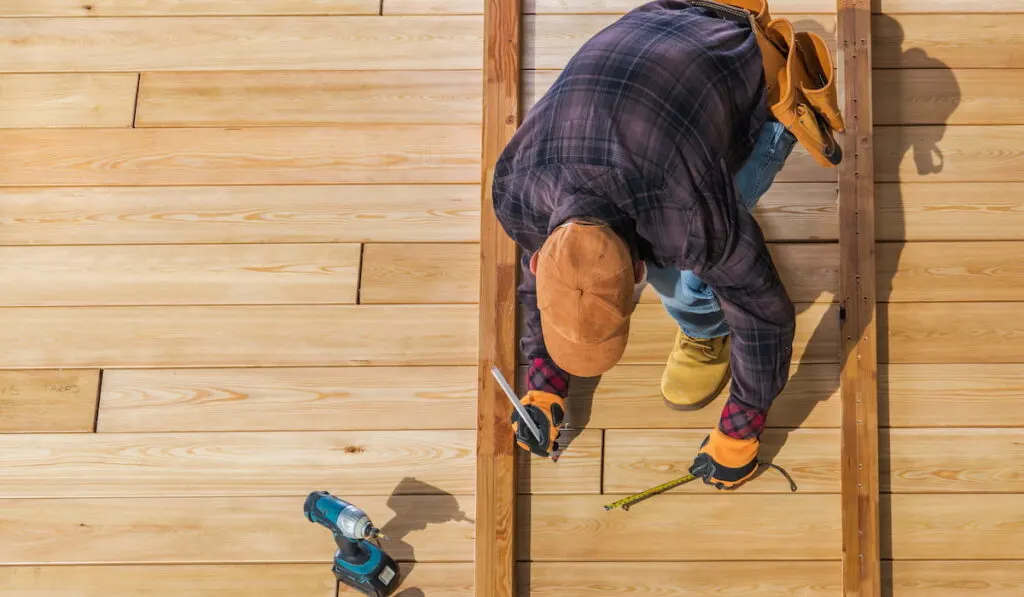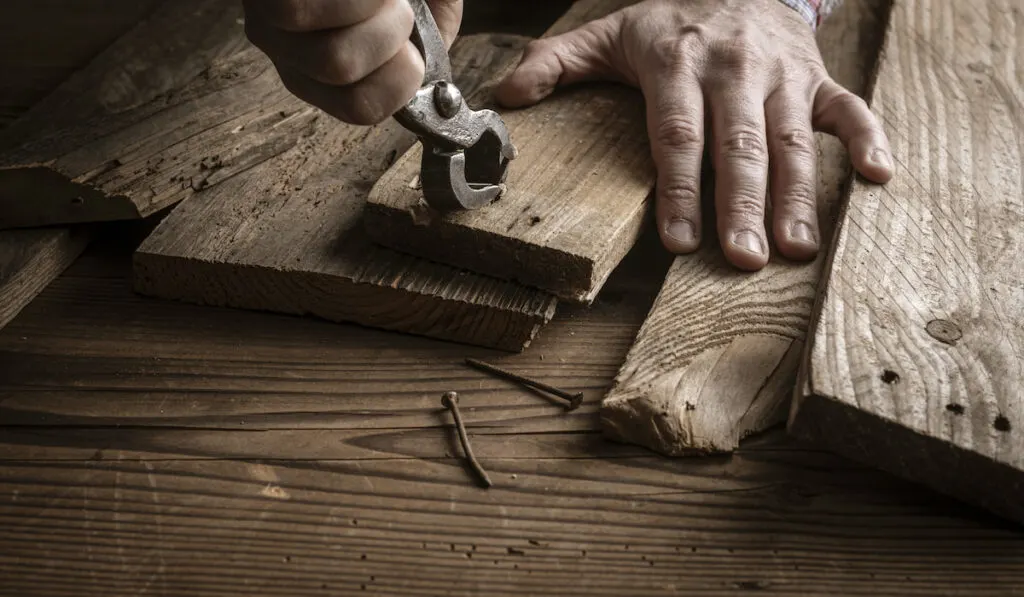*This post may have affiliate links, which means I may receive commissions if you choose to purchase through links I provide (at no extra cost to you). As an Amazon Associate, I earn from qualifying purchases. Please read my disclaimer for additional details.
Whether you have a brand new deck or one that has been in place for many years, you may notice that it has a little shake or wiggle when you walk on it. So, is this wiggle safe, and should a deck shake when walking on it?
You never want to ignore a shaking motion from your deck when you walk on it. While it might seem insignificant, a constant shaking motion can pull the deck away from the wall and could become unsafe.

Since a safe deck shouldn’t move or shake; you might be wondering what you can do to sturdy yours and make it more solid and safe.
This article will list why decks start to wiggle and wobble and the different options you have to fix them.
Table of Contents
Should My Deck Shake When Walking on It?
Shaky decks are fairly simple to fix and usually aren’t extremely dangerous. However, ideally, decks shouldn’t shake, and over time, the shaking can cause damage and eventually become a hazard.
While a small shake might seem like a big deal, it can worsen over time and become problematic in the future.
Whether you are a DIY kind of person or would prefer to leave the job up to the professionals, getting your shaky deck back in shape should be taken care of as soon as possible.
Why Does My Deck Shake When Walking on It?
Whether you notice a small shake when you walk on your deck or a huge sway, there are a few different reasons for these unbalanced issues. If you feel something is off with your deck, consider a few things to fix this problem.
Warped Beams
Over the years, your deck will go through a lot of weathering, wear and tear, and tons of use. All of these factors can cause your deck beams to break, rot, and deteriorate, causing them to lose much of their support.
When replacing the deck beams, make sure you are using treated wood to ensure many years of use before requiring more maintenance.
Loosened bolts
Like wooden beams, the holes where screws and bolts are placed into the deck will move around a lot while in use. These holes will slowly start to expand, and the screws, nails, and bolts will begin to fall out.
Without these fasteners securely in place, your deck will begin to wobble.
The biggest culprit when it comes to lacking deck support is loosened or missing nails in the joist hangers.
A Wide Distance Between Joists

When you want to build a stable deck, you will have to make sure plenty of secure beams are in place and close to one another.
If there is too much spacing between the frame joists, your deck wants it to be as solid as possible.
Joist beams are the framing for your deck that keeps it solid and prevents the flooring from buckling underneath, making it an important part of keeping your deck still.

How Do You Fix a Deck that Shakes When You Walk on It?
Now that you know most of the major reasons for shaky decks, here are a few ways you can fix these issues to keep them in place. But, before getting out your tools, make sure you have a good idea of where the problem lies, even calling in a pro when necessary so you don’t have to go back and do it again.
Add Support to the Deck
Adding additional support to your deck will keep it from having the ability to move around where it sits; this support can come in different forms, but all of them offer similar outcomes.
Deck support options include:
T-braces
The T-brace is one way to install a sturdy deck. This is a metal bar that lays diagonally across the top of the joists, or you can use this method by placing a deck board diagonally underneath the frame.
Cross Bracing or X Brace
There are two ways to add X-braces to your frame, with verticle braces being the better option with a much more solid hold. You can hide an x-brace running them horizontally underneath the joists, but they might not be as supportive.
V-Bracing
A V-brace is when you use wooden planks to add support to your deck by connecting them to the frame from the support post, creating a V-shape, and keeping a diagonal formation.
A diagonal connection will always give you the best outcome when attempting to keep a surface from moving around.
Remove and Replace Old Nails

Deck nails are typically strong and made from durable materials; however, over time, they will start to rust and weaken, eventually becoming loose or falling out.
If the fasteners are not securely in place, the structure will not be sturdy and will eventually start to shake and move around.
When your deck begins showing signs of wiggling, check out the deck nails, and if they need replacing, make sure you purchase nails specifically made for the deck, and new holes are created.
If you try and insert nails into the older, used holes, the problem will quickly form again.
Replace Old Warped or Broken Boards
If your deck seems to be shaky on specific boards or in certain areas, there might be an issue with the wooden boards themselves. If this is the case, you can easily remove old, rotten, or warped boards and replace them with fresh, durable ones to provide a more sound structure.
Check the Ledger Board
The Ledger board is the board responsible for holding the deck up against the house. If the bolts or nails connecting this part in place are loose, or the board is wrapped or broken, then the frame of your deck will begin to pull from the structure of the home, making it shake and move much more than it should.
If you find the ledger board is faulty, replace it as soon as possible, this part of the deck is very critical to the safety of the structure.
Add Support to the Base
If your support beams are not securely in place on (or in) the ground, this can cause the deck to move under your feet.
Making sure you have great support at the bottom of the beam is crucial to have a sturdy deck.

Should You Fix a Swaying of a Deck?
While a swaying deck might not seem like a gigantic issue to many, it can be a serious problem. There are many cases where swaying was one of the first signs of a faulty deck, which eventually fell, injuring and even killing people during the event.
The more your deck sways, the looser all of the parts holding it together become, eventually breaking down the structure completely and creating a situation where serious issues can arise.
Another big reason to fix a swaying deck asap is that the quicker you get to the bottom of the issue, the cheaper the repairs are going to be, and less amount of labor will be required.
Summing Things Up
In short, no, your deck should never sway when you walk on it, and if it does, you should figure out the cause and fix it as soon as possible to save money on expensive future repairs and to prevent your deck from falling apart and hurting yourself, your family, or guests.
